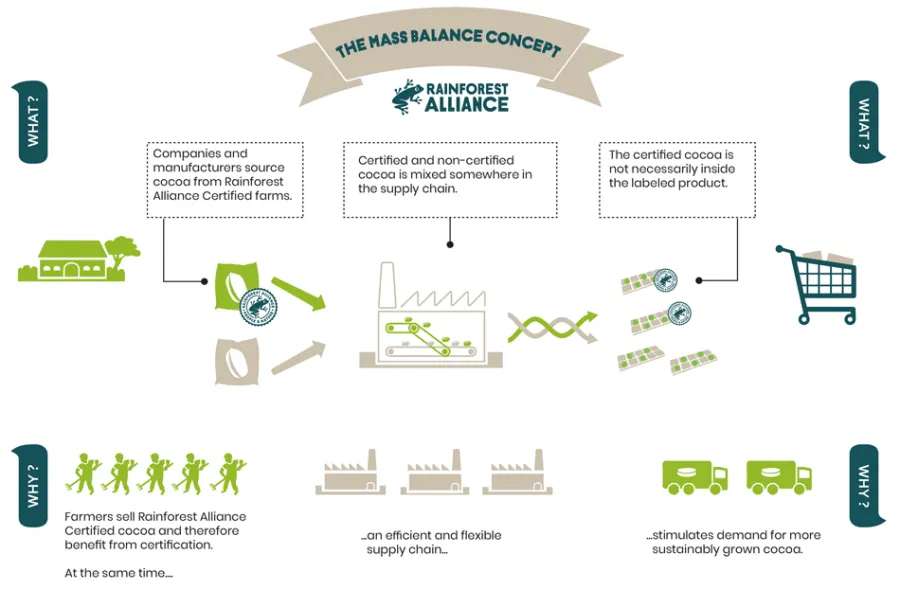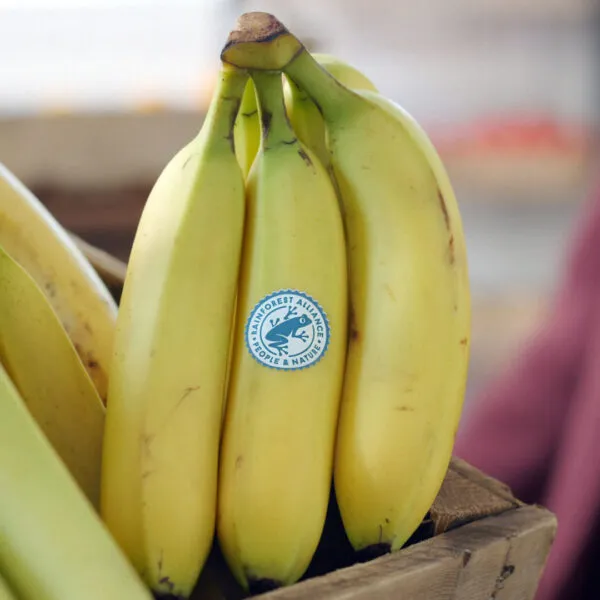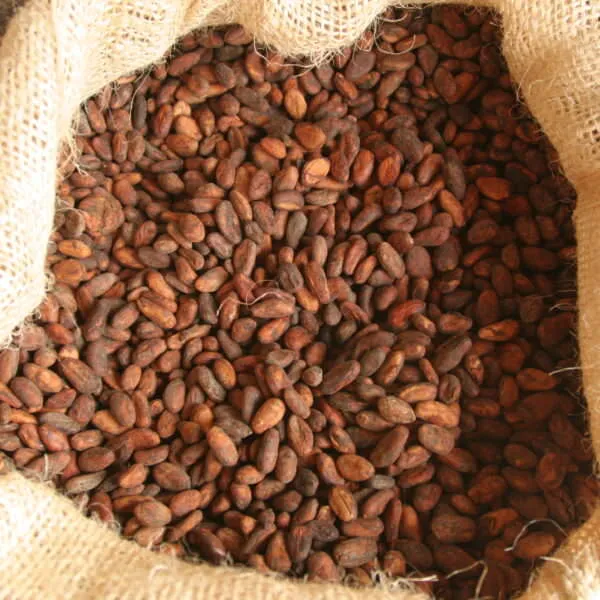There are multiple ways to source certified ingredients for consumer products. When companies keep the ingredients purchased from a certified farm physically separated from non-certified ingredients throughout the whole supply chain, we call it a “segregated model” of sourcing. When companies opt for “mass balance” sourcing, the certified and non-certified ingredients are mixed together somewhere in transit or production of the end product.
While both segregated and mass balance models have their pros and cons, it’s important to note that their impact is the same for farmers. Both methods require companies to purchase the amount of ingredients that are needed for their product from a certified farm. This video explains the concept of mass balance:
Keep reading for our responses to the most commonly asked questions about mass balance sourcing.
What is mass balance and how does it work?

Mass balance is a sourcing method that allows for certified and non-certified ingredients to become mixed during the shipping and manufacturing processes. All major international sustainability initiatives use mass balance in one form or another.
Overview of sectors for which the Rainforest Alliance offers mass balance traceability:
| Mass balance allowed at supply chain level | Mass balance allowed at farm certificate holder and supply chain level |
|---|---|
| For more information, please consult the Traceability Guidance, Annex Mass Balance requirements, chapter c. | For more information, please consult the Traceability Guidance, Annex Mass Balance requirements, chapter d. |
Using the seal
In this system, a product—let’s take a chocolate bar, as an example—can carry the Rainforest Alliance Certified seal only if the total quantity of cocoa purchased from Rainforest Alliance Certified farms is equivalent to the total amount used in manufacturing the product. In simpler terms, for every gram of cocoa in that chocolate bar, you can be certain that a gram of cocoa has been purchased from a certified farm.
Why use mass balance?
Mass balance is a great way to scale up sustainability, as it’s more affordable for companies than setting up a segregated supply chain. We encourage companies to use a segregated sourcing model because the certified ingredients are kept separate from non-certified ingredients. In some cases, the segregated model makes it possible to trace the certified ingredient inside the finished product back to the farm(s) where it was grown. We call this “Identity Preserved.” In other cases, ingredients from different certified farms may be mixed somewhere in the process. A segregated sourcing model is commonly used for certified products like coffee and tea.
More companies buy certified
Mass balance sourcing is a good alternative if segregation isn’t a feasible option, because certain supply chains are complex. For some products—like cocoa, orange juice, and coconut oil—the higher cost of segregation (such as separate tanks and silos) would divert funds away from where they matter most: investing in more sustainable farming practices that protect nature and improve the lives of farmers and their families. That’s why we offer a mass balance sourcing model that encourages companies to make the transition towards buying (more) ingredients from Rainforest Alliance Certified farms.
More farmers benefit
As mass balance sourcing makes it more affordable for companies to source certified crops, this, in turn, increases the demand. This means that more farmers can benefit from the social and economic advantages (including higher incomes and better working conditions) associated with our certification programs. After all, what’s important for farmers is that they sold their cocoa as certified. It doesn’t matter to them whether the cocoa ends up in one chocolate bar or another.
How can you be sure product claims about the Rainforest Alliance are reliable?
Mass balance sourcing is credible because our traceability systems ensure that the volumes of certified ingredients bought for products with our seal were actually grown on certified farms. Therefore, you can trust that farmers have benefitted from selling their certified crops.
Additionally, we’re introducing Origin Matching Mass Balance in cocoa, which will better support farmers in the countries that sell cocoa for products that carry our seal. Origin mass balance means that, even if certified cocoa mixes with non-certified cocoa during the sourcing process, the country of origin remains the same. So, if a chocolate bar of a certain brand claims to have cocoa from Papua New Guinea, the brand must purchase the volume needed for that product from certified cocoa farms in Papua New Guinea. The aim of origin matching is to support farmers in the region of production.
Learn more about what Rainforest Alliance Certified means and what’s behind our seal.



